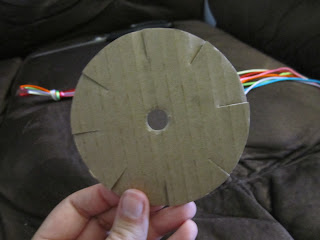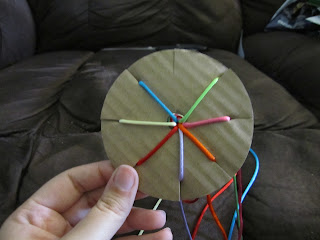What You Need:
- 2 paddle pop sticks
- 2 small rubber bands
- 1 large, wide, flat rubber band (It's important that it is wide and flat. I've tried with the regular thin ones and they just don't work. The ones I use are between 0.5 and 0.7 cm wide)
- paper
- tape
- scissors
- Cut two little strips of paper. (Mine are 2cm x 5cm, but they just need to be wide enough that you tape doesn't hand off the edges and long enough they they go around both paddle pop sticks with a little overlap)
- Place one paddle pop on top of the other and wrap the piece off paper around each end of the sticks, tapeing them to hold the right size.
- Slip one stick out and set aside for a moment.
- Stretch the large, wide rubber band from one end of the stick with the paper on it to the other as shown below:
- Sandwich the paddle pop sticks together once more and wrap the smaller rubber bands around each end of the sticks, ensuring they are bound together securely. Make sure these rubber bands do not catch the paper beneath them.
- Blow! Place the centre of the harmonica between your lips and blow. If you're successful you will hear a buzzing, kazoo like noise.
HINT! You can change the pitch of the noise by altering what we musicians call embouchure (Yay! Technical words!) which is basically the use of facial muscles and the shaping of your lips, along with the speed at which you blow the air out. Tighten lips and blow faster for higher notes. Loosen lips and blow slower for lowere pitches.
Or you can just tell the kids to blow harder for high notes and softer for low notes. That might satisfy them for a while...
HINT! Try using the big tongue depresser paddle pops too!
TIP! If your harmonica is not making a noise have a close look at the middle of the instrument (the area between the two pieces of paper). I learned while making them with the kids that the ones that work have teeny tiny gap between the paddle pop sticks. You should be able to see light through it.
If you don't have a gap, there's no room for vibrations. If there's no vibrations, there's no sound. (Ohhhhh, science!). I like to make sure that at least one of my sticks is slightly bowed.
WARNING! This is a noisy craft! You may want to have a stash of ear plugs at the ready for children and staff that are sensitive to noises, as there will be a lot of it. Once a child has a harmonica and has figured out exactly how to play it, he or she is likely to play it for the rest of the day. Maybe it's best to send them outside to play directly after making them?
Enjoy! And don't hesitate to let me know what you think in the comments section!















